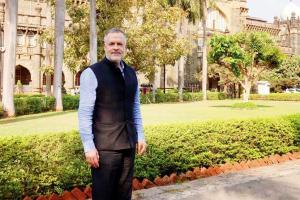The director of the British Museum, in the city for a training programme, talks culture and conservation and why he loves Mumbai's new children's museum

Hartwig Fischer at the CSMVS Museum
Since you took over as director of the British Museum, what has been your most rewarding moment so far?
There have been many rewarding experiences, working with great colleagues in London and on all continents, with great and small institutions around the globe, working for a global audience, and for a collection of world cultures. But one particularly rewarding moment was the opening of the India and the World exhibition at the Chhatrapati Shivaji Maharaj Vastu Sangrahalaya (CSMVS) in November 2017, an exhibition we have worked on together intensely, and which offered a new way to explore the many aspects of India's great past (and present) in a global context, a country of multiple cultures, faiths, experiences, styles, and artistic expressions. It's a country that over millennia has inspired the world, and has been inspired by the world. We were all aware of working on something unprecedented and exciting, something innovative, a new model of exhibition, with half of the works coming from Indian collections, the other half from the British Museum (BM). The show was seen by more than 2,00,000 people in Mumbai and was received with great enthusiasm.
ADVERTISEMENT
How have you seen museum learning evolve in the 21st century? Is there enough digital engagement being created globally?
There is a beautiful Tirthapata at CSMVS. You remember, the Shwetambara Jains hold five places as sacred that you are supposed to visit during your lifetime. Those who cannot travel right now can instead look at the Tirthapata depicting the five sites in order to do pilgrimage. Museums are like Tirthapatas, they make you travel to significant places — remote in space, and time — to learn and to be enlightened without moving.
In order to do that in a museum, you have to learn how to use it. And education in a museum does just that: it makes you discover not only a great number of ideas and objects and cultures different from those you are familiar with, it also gives you the know-how and tools to accomplish that journey and to get the most out of it, encountering other epochs and regions, and the works of great artists. In a museum, objects are key; they have the magic, presence and beauty that triggers new experience. But at the same time, you need text, labels and panels, audioguides and guided tours to learn more. You need all forms of contemporary learning — and museum educators are notoriously inventive people — to engage people of all ages, particularly children. Education transforms museums into extraordinary spaces of social interaction. And you need digital, the most potent and versatile technique we have, to communicate all this and to enrich, prepare and deepen your experience, inside and outside the museum.
At the CSMVS and the BM, digital already plays an important role, and as the technique evolves so will the many uses the museum can make of it. There will always be more, there will never be enough. And at the museum, human beings and their encounters with inspiring objects and works will remain at the heart of all experience.
What are your thoughts on the newly-opened Children's Museum at CSMVS Mumbai?
It's a wonderful place! Situated on one side of CSMVS's beautiful garden, it is discreet and present at the same time, a little masterpiece of contemporary architecture. I like to look at the building, stand on its terrace among the branches of the mango tree, or sit on the benches underneath the grand baobab, and I like to look out from inside onto the garden and the main building.
It sets a new standard of how to welcome children to the museum and take them seriously. They have a lot to teach us about the world. The exhibition created by inspired young curators is a brilliant example.
Have growing cultural exchanges among museums of the world facilitated conservation practices?
Yes undoubtedly. And the fascinating CSMVS exhibition dedicated to the work of conservators and their endeavours to preserve the museum’s objects gives you a good impression right now of just how important the exchange has become. Conservators from our museums share skills and experiences of working with different material from different climes, they discuss methods and techniques and newest equipment, but also underlying principles and conservation philosophies to make sure they are up to date and do justice to the objects entrusted to them. This has grown into a truly international dialogue, with great institutions like the Getty Conservation Center in Los Angeles as supporters and facilitators on a global scale, partnering with museums and heritage institutions across the world. The CSMVS itself is setting a standard in developing conservation projects in partnership with other museums and cultural heritage institutions across India.
Best at the British Museum, London
- If you travel this spring, you must see the Munch exhibition, and the Manga exhibition, they are stunning.
- In the autumn, you will see an exhibition on Troy that is unlike any other exhibition you have ever seen on a great ancient culture.
Catch up on all the latest Crime, National, International and Hatke news here. Also download the new mid-day Android and iOS apps to get latest updates
 Subscribe today by clicking the link and stay updated with the latest news!" Click here!
Subscribe today by clicking the link and stay updated with the latest news!" Click here!







